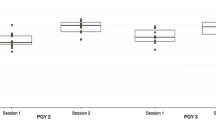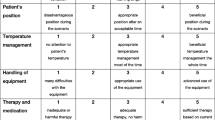Abstract
Objective
To develop and test the validity of an objective structured assessment of technical skill (OSATS) tool for vertex presentation delivery simulations.
Materials and methods
Monocentric prospective study conducted in the Department of Gynecology, Obstetrics, Fetal Medicine and Reproductive Biology at the University Hospital of Nice. The study consisted of two parts, the development of the scoring system and then its validation. Experts in obstetrics from several academic institutions and private French hospitals were invited to participate in the development phase of the scoring system. For the validation phase, we formed a group of 20 novices and a group of 20 experts, who performed a childbirth simulation according to a standard scenario. Each participant was filmed and then two experts evaluated their performance with the OSATS score by viewing anonymized videos.
Results
The scores obtained by the expert group were significantly higher than those of the novice group, whether we compared the total score or each part of the score (task-specific or global) independently. We obtained a p value of 0.03 for the total score, p = 0.036 for the task-specific score, and p < 0.001 for the overall score.
Conclusion
The OSATS score developed in this study for vertex presentation delivery is a reliable mean to assess the medical students’ competence in procedural skills using a simulator.

Similar content being viewed by others
References
Jude DC, Gilbert GG, Magrane D (2006) Simulation training in the obstetrics and gynecology clerkship. Am J Obstet Gynecol 195(5):1489–1492. doi:10.1016/j.ajog.2006.05.003
Tavakol M, Mohagheghi MA, Dennick R (2008) Assessing the skills of surgical residents using simulation. J Surg Educ 65(2):77–83. doi:10.1016/j.jsurg.2007.11.003
Khaskheli M, Baloch S, Baloch AS (2012) Obstetrical trauma to the genital tract following vaginal delivery. J Coll Physcians Surg-Pak 22(2):95–97 02.2012/JCPSP.9597
Chipman JG, Schmitz CC (2009) Using objective structured assessment of technical skills to evaluate a basic skills simulation curriculum for first-year surgical residents. J Am Coll Surg 209(3):364–370
Martin JA, Regehr G, Reznick R, MacRae H, Murnaghan J, Hutchison C, Brown M (1997) Objective structured assessment of technical skill (OSATS) for surgical residents. Br J Surg 84(2):273–278
Graham B, Regehr G, Wright JG (2003) Delphi as a method to establish consensus for diagnostic criteria. J Clin Epidemiol 56(12):1150–1156
Iyer, Santen SA, Nypaver M, Warrier K, Bradin S, Chapman R, McAllister J, Vredeveld J, House JB, Accreditation Council for Graduate Medical Education C, Emergency M, Pediatric Residency Review C (2013) Assessing the validity evidence of an objective structured assessment tool of technical skills for neonatal lumbar punctures. Acad Emerg Med: J Soc Acad Emerg Med 20(3):321–324. doi:10.1111/acem.12093
Goff BA, Lentz GM, Lee D, Houmard B, Mandel LS (2000) Development of an objective structured assessment of technical skills for obstetric and gynecology residents. Obstet Gynecol 96(1):146–150
Maagaard M, Oestergaard J, Johansen M, Andersen LL, Ringsted C, Ottesen B, Sorensen JL (2012) Vacuum extraction: development and test of a procedure-specific rating scale. Acta Obstet Gynecol Scand 91(12):1453–1459. doi:10.1111/j.1600-0412.2012.01526.x
House JB, Dooley-Hash S, Kowalenko T, Sikavitsas A, Seeyave DM, Younger JG, Hamstra SJ, Nypaver MM (2012) Prospective comparison of live evaluation and video review in the evaluation of operator performance in a pediatric emergency airway simulation. J Grad Med Educ 4(3):312–316. doi:10.4300/JGME-D-11-00123.1
Vogt VY, Givens VM, Keathley CA, Lipscomb GH, Summitt RL Jr (2003) Is a resident’s score on a videotaped objective structured assessment of technical skills affected by revealing the resident’s identity? Am J Obstet Gynecol 189(3):688–691
Moreau R, Pham MT, Brun X, Redarce T, Dupuis O (2008) Assessment of forceps use in obstetrics during a simulated childbirth. Int J Med Robot 4(4):373–380. doi:10.1002/rcs.222
Conflict of interest
We declare that we have no conflict of interest.
Author information
Authors and Affiliations
Corresponding author
Rights and permissions
About this article
Cite this article
Antomarchi, J., Delotte, J., Jordan, A. et al. Development and validation of an objective structured assessment of technical skill tool for the practice of vertex presentation delivery. Arch Gynecol Obstet 290, 243–247 (2014). https://doi.org/10.1007/s00404-014-3204-x
Received:
Accepted:
Published:
Issue Date:
DOI: https://doi.org/10.1007/s00404-014-3204-x




